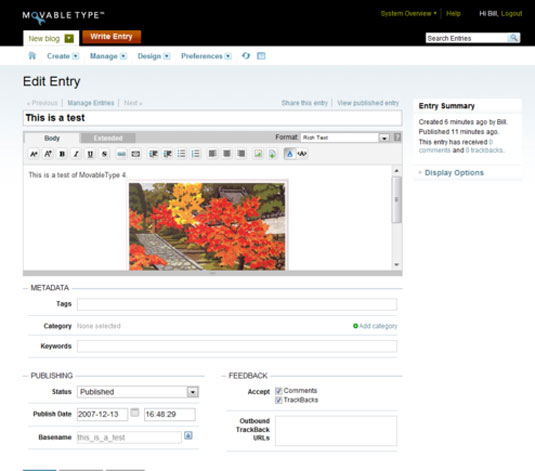A history of blogging
Blogging has only existed for 20 years. Movable Type takes a look back at how it first began, and evolved into the powerful media it is today.

There are very few websites online today that don't incorporate some form of blog. Whether it's an international news outlet, a local restaurant or your friend's online diary, it seems like everybody these days is blogging about something. But this hasn't always been the case.
Blogging has only existed for about 20 years. However, a lot has happened in those 20 years.
Somewhere along the line, blogs stopped only being a place for angsty teens to share their innermost thoughts and personal poetry. Somehow, along the way, they became an absolute necessity for everyone - even big names like CNN, Coca-Cola, and Google.
Here we take a look at how individuals' need for a simple mechanism to easily update website content evolved, and eventually turned the way we spread ideas completely on its head.
The early days
The early internet was raw. It was clunky. It was ugly. But, even in its roughest form, it gave people the chance to share their ideas with speed and convenience.
In the early 1990s, web pioneers created sites with bulletin boards and discussion forums. Here, they'd host back and forth conversations on anything from fan-fiction, to technology, to sports, to sci-fi. People also signed up for listservs about topics that interested them, where experts and thought leaders would publish interesting content in email form.

In 1994, the world witnessed the birth of what many agree to be the very first blog. It was called Links.net - a place where creator Justin Hall could share his musings and, well, his favourite links, with the world. It was just a simple page with manually updated HTML (and it still is), but it changed the course of how we share ideas and content on the web.
Get the Creative Bloq Newsletter
Daily design news, reviews, how-tos and more, as picked by the editors.
A few years later, in 1997, as more and more users began using personal websites as a place to spotlight their ideas, the term "weblog" was coined - and then shortened to "blog" in 1999.
The era of online diaries
The trend caught on fast, and immediately people needed a better way to post content without manually updating their page's HTML. This need gave rise to a slew of early blogging platforms.
The initial adopters were individual users, many of them young and technologically savvy. It follows, then, that early blogs were very much in the vein of online diaries.
They were a place that individuals could share their thoughts, feelings, and experiences with a small, intimate audience of their friends and family. Back then, you didn't write a blog post and share it on Facebook. You didn't join content networks or outwardly promote your work. Blogging was private - something to be shared with only those who knew where to find you.
Early bloggers hosted content on sites like Xanga, founded in 1998, and LiveJournal, which came out the next year. They were relatively simple - users were mostly only able to swap out color schemes and minor layout pieces - but highly effective at allowing users to publish quickly and easily.

It didn't take long, though, for blogging to get so popular that users actually started to seek out great content to read. They started looking beyond their immediate circle because they wanted to find the best blogs and the best content on the web.
And that changed everything.
The paradigm shift
Around this time, in 1998, the Charlotte Observer sent a team of journalists and photographers to cover Hurricane Bonnie. Their coverage was both the fastest and the most comprehensive of any outlet in the area, but editors were frustrated that newspaper lag time would give their competitors a chance to catch up. It would even the playing field, so to speak. And, though their team had been there first, it would force them to consolidate all the information and photos they collected into a small print space.
So, they did something that hadn't been done in mainstream news to that point. They set up a blog.
There, the paper's reporters sent dispatches from the field and kept readers up to date on the hurricane's path and damage. The Bonnie blog set records for page views on the Observer's site. It also set the stage, along with Drudge Report's breaking of the Clinton-Lewinsky scandal, for a major shift in the way blogging platforms were used.
The expansion of blogging
In short, online news outlets were gaining credibility. And now, more than ever, they needed a way to rapidly update content, manage archives, and interact with their user base.
In 2001, SixApart launched Movable Type, which offered high performance blogging capabilities to organizations both large and small. WordPress followed in 2003, and together the two offered brand new capabilities for large editorial teams to publish and manage content.

Also in 2003, Google launched AdSense, which allowed bloggers to collect income from the work they produced. Soon, there were hundreds of blogs and bloggers who specialized in how to make money with your blog.
Newspaper integration
With rising demand for fresh and high-quality content, a handful of enterprise-level blogging platforms, and a new ability to monetize internet publishing, it wasn't long before the world's biggest names in news and content hopped on board.
In just a few short years, outlets like the Huffington Post had integrated with Movable Type while CNN had adopted WordPress.
By 2007, 95 per cent of US newspapers had integrated blogging into their online news delivery.
Blogging today
In 2011, more than half of US internet users were reading blogs at least once a month. Today, some estimate that more than 400 million people actively read blogs. And that number will only continue to grow. But today, the line between what does and does not constitute a blog is more blurred than ever.
Journal-style blog platforms targeted toward teens are as popular as ever, as are mid-level free platforms like Typepad and Blogger that allow people to share their passions with a wider audience. And, of course, most respected news outlets rely, at least in part, on blogging in order to bring their subscribers the best and most urgent news.
But the importance of great content isn't just for the unbiased any more. Today, the world's biggest brands use blogs to tell their story, promote their products, and connect with their audiences in ways that were once considered impossible.
So what does it all mean?
It means the most exciting trend in blogging is that, as it evolves, it only gets more inclusive.
The future of blogging
As excitement builds around minimalist platforms like Ghost and Medium that champion writers and great content, there will always be a need for platforms that allow you to build complex, multi-layered websites.
As the need grows for platforms that are optimized for microblogging and personal journaling, there will always be a need for proven, stable builds that large organizations can use to scale their content strategies across the globe.
It's hard to predict precisely what form blogging will take next. What's certain, though, is that as the form changes and different platforms come and go, blogging is - and will always be - about sharing ideas with the world.
That, at least, will never change.
Words: Movable Type

Thank you for reading 5 articles this month* Join now for unlimited access
Enjoy your first month for just £1 / $1 / €1
*Read 5 free articles per month without a subscription

Join now for unlimited access
Try first month for just £1 / $1 / €1

The Creative Bloq team is made up of a group of art and design enthusiasts, and has changed and evolved since Creative Bloq began back in 2012. The current website team consists of eight full-time members of staff: Editor Georgia Coggan, Deputy Editor Rosie Hilder, Ecommerce Editor Beren Neale, Senior News Editor Daniel Piper, Editor, Digital Art and 3D Ian Dean, Tech Reviews Editor Erlingur Einarsson, Ecommerce Writer Beth Nicholls and Staff Writer Natalie Fear, as well as a roster of freelancers from around the world. The ImagineFX magazine team also pitch in, ensuring that content from leading digital art publication ImagineFX is represented on Creative Bloq.
